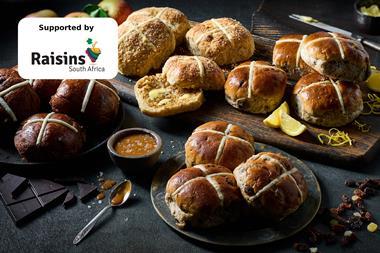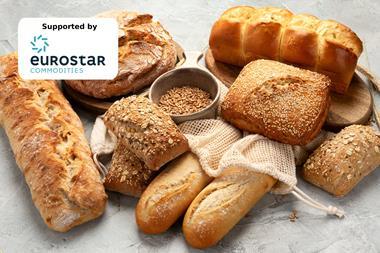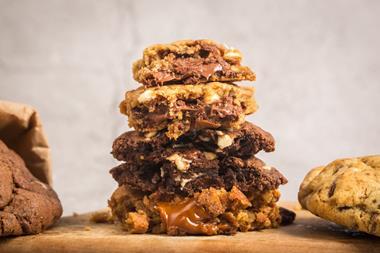Hot cross buns dominate the Easter bakery selection, but is it time bakers branched out?
One a penny, two a penny, hot cross buns. From the nursery rhyme to supermarket shelves, there’s no escaping the iconic bakery treat at this time of year.
But is the popularity of this seasonal treat leading bakers to put all their eggs in one basket? After all, there’s a plethora of seasonal inspiration from around the world that could be put before UK consumers, from Poland’s babka to Dutch paasbrood.
“The rise of ‘foodie-ism’ in the UK, with one in three consumers now describing themselves as a foodie, underpins the appeal of baked goods from around the globe,” explains Emma Clifford, associate director, UK food and drink research at Mintel.
“One in four buyers of bread and baked goods would like to see more products that are traditional to other countries, rising to a third of those who live in London and those in the AB socio-economic group.”
To date, this has predominantly been limited to Indian and Italian breads, notes Clifford, with innovation largely limited to variants of breads already well-accepted by Brits. Panettone is one example: the Italian sweet bread has become a staple at Christmastime, with recent innovation such as Heston’s Waitrose Black Forest Panettone, and a salted caramel offering from Selfridges.
Clifford believes Easter presents similar opportunities to try something new. “Linking limited-edition bread and baked goods to seasonal events such as Easter or Christmas, or even cultural events around the world, creates a real sense of occasion to encourage product trial,” she says.
Steps, albeit small ones, are being taken towards this. In 2016, Waitrose became the first UK supermarket to sell colomba – a dove-shaped sweet Italian yeast bread featuring candied fruits – while Carluccio’s and Selfridges have sold it in the past.
However, many of the traditional European Easter breads (see box out above) remain confined to specialist delis catering for consumers from those communities.
The good news is that many of these breads have similarities to hot cross buns and simnel cake, such as spices, orange and dried fruit – meaning consumers won’t have to venture too far out of their comfort zones as Easter weekend (30 March to 1 April) approaches.
Innovative additions can complement the traditional Easter treats and, given that 20 million packs of hot cross buns were purchased from major retailers across the UK in 2017’s Easter week alone, they cannot be ignored.
But that doesn’t mean bakers have to shun innovation. Tesco, for example, believes bigger is better, as it is offering a Giant Hot Cross Bun (four times the size of a normal one) alongside a Tear and Share Hot Cross Bun. Others, meanwhile, believe new flavours are the way forward.
“I see a growing market offering chocolate chips instead of the traditional fruit and mixed peel,” says Ann-Marie Dunne, bakery lecturer at Dublin Institute of Technology, noting combinations such as cranberry & orange, pistachio or cherry & almond.
“Sometimes a product that is familiar is easier to promote, especially when the season is so short, by making variations of the traditional.”
New formats and hybrids also present opportunities, believes Cristiana Ballarini, category marketing director for pastry ingredients at CSM Bakery Solutions. “Consider mixing traditional and modern. For something different, create hot cross bun cupcakes, loaves and biscuits. Alternatively, add simnel spice to traybakes and cakes.”
Regardless of the traditions this Easter, a little diversification could certainly add some spice to sales.
Spice up your Easter offer
Hot cross buns, lavish cakes and classic chocolate nests remain family favourites at Easter time. Here, industry experts give their take on how to shake things up:
Ann-Marie Dunne, bakery lecturer, Dublin Institute of Technology: “Decorating gateau with chocolate drips down the side is in vogue and decorating the tops using various chocolate bars is very tempting. A similar trend could be used on cakes and cupcakes as chocolate is always the big tradition at Easter.”
Cristiana Ballarini, category marketing director, pastry ingredients, CSM Bakery Solutions: “Bunnies, flowers and flowerpots, bees and bonnets can all look attractive on biscuits, traybakes, cupcakes and crispy cakes. Flavours popular at this time are lemon and orange, chocolate and honeycomb, so consider creating a range to appeal to each of these tastes.”
Jacqui Passmore, marketing manager, Dawn Foods UK and Ireland: “Use toppings with lots of colours as well as chocolate decorations like Easter bunnies, chocolate flowers and assorted coloured chocolate shavings.”
Jeremy Gilboy, managing director, Carrs Foods: “Filling brioche tear & shares with jam and cream transforms them into a substitute for an Easter cake.”
Here’s a brief rundown of Easter breads and cakes from across Europe
1. Babka: Not to be confused with the Jewish bread of the same name (which is made from an enriched dough and often flavoured with chocolate or cinnamon), Easter babka is a sweet yeast cake. It’s popular in Poland and Eastern European countries, and is similar in design to a Bundt cake.
2. Tsoureki: Hailing from Greece, the tsoureki is a braided brioche-like bread that can be served as a loaf or in a circle, often with dyed red eggs. Traditionally it is flavoured with an essence drawn from the seeds of wild cherries or mastic, but is often sprinkled with nuts such as blanched almonds.
3. Pane di Pasqua: This loaf is braided around colourful dyed eggs and sometimes topped
with sprinkles to add even more colour. Like many others on this list, it’s similar in style to a brioche and can be flavoured with lemon and a touch of ground aniseed.
4. Paska: This round loaf originated in Ukraine, and is enjoyed across Eastern Europe in countries such as Romania, Slovakia and Bulgaria. Traditionally, the slightly sweet loaf is decorated with religious symbols and is used as the central focus of Ukrainian Easter baskets.














































No comments yet